Write your liveness analysis in the file cs6340srcLivenessAn
Write your liveness analysis in the file cs6340/src/LivenessAnalysis.java and your reaching definitions analysis in the file cs6340/src/ReachDefAnalysis.java .
Follow the instructions in those files for how to write the analyses.
LivenessAnalysis.java
import chord.project.Chord;
import joeq.Compiler.Quad.RegisterFactory.Register;
@Chord(name=\"liveness\")
public class LivenessAnalysis extends DataflowAnalysis<Register> {
@Override
public void doAnalysis() {
// Implement your liveness dataflow analysis here.
//
// File DataflowAnalysis.java defines instance fields main, inMap, and
// outMap, which will serve as the inputs and outputs of your analysis:
//
// INPUT: Method main.
//
// OUTPUT: Populate maps inMap and outMap with the results of your
// liveness analysis of method main.
//
// Specifically, for each Quad q in the control-flow graph of main,
// inMap(q) and outMap(q) must contain the sets of all Registers that
// may be live on entry and on exit, respectively, of q. You can leave
// a set either null or empty if it does not contain any registers.
//
// Your analysis will be graded for the following aspects in decreasing
// order of importance:
// 1. Correctness of the results produced by the analysis.
// 2. Efficiency of the analysis, in particular, the number of times you
// revisit each quad.
//
// Add helper instance methods to this class if necessary. All your
// code must be in this class itself, and it must be written in Java.
//
// Note: This is a single procedure analysis; you do not need to
// consult any pointer analysis, call graph, or any method of the given
// program besides the provided main method.
}
}
ReachDefAnalysis.java
import chord.project.Chord;
import chord.util.tuple.object.Pair;
import joeq.Compiler.Quad.Quad;
import joeq.Compiler.Quad.RegisterFactory.Register;
@Chord(name=\"reachdef\")
public class ReachDefAnalysis extends DataflowAnalysis<Pair<Quad, Register>> {
@Override
public void doAnalysis() {
// Implement your reaching definitions dataflow analysis here.
//
// File DataflowAnalysis.java defines instance fields main, inMap, and
// outMap, which will serve as the inputs and outputs of your analysis:
//
// INPUT: Method main.
//
// OUTPUT: Populate maps inMap and outMap with the results of your
// reaching definitions analysis of method main.
//
// Specifically, for each Quad q in the control-flow graph of main,
// inMap(q) and outMap(q) must contain the sets of all <Quad, Register>
// definitions that may reach the entry and the exit, respectively, of
// q. You can leave a set either null or empty if it does not contain
// any reaching definitions.
//
// Your analysis will be graded for the following aspects in decreasing
// order of importance:
//
// 1. Correctness of the results produced by the analysis.
// 2. Efficiency of the analysis, in particular, the number of times you
// revisit each quad.
//
// Add helper instance methods to this class if necessary. All your
// code must be in this class itself, and it must be written in Java.
//
// Note: This is a single procedure analysis; you do not need to
// consult any pointer analysis, call graph, or any method of the given
// program besides the provided main method.
}
}
Solution
LivenessAnalysis.java
import chord.project.Chord;
import chord.project.analyses.JavaAnalysis;
import chord.program.Program;
import joeq.Class.jq_Method;
import joeq.Compiler.Quad.*;
import joeq.Compiler.Quad.RegisterFactory.Register;
import joeq.Compiler.Quad.Operand.RegisterOperand;
import java.util.*;
@Chord(name=\"liveness\")
public class LivenessAnalysis extends DataflowAnalysis<Register> {
@Override
public void doAnalysis() {
// Implement your liveness dataflow analysis here.
//
// File DataflowAnalysis.java defines instance fields main, inMap, and
// outMap, which will serve as the inputs and outputs of your analysis:
//
// INPUT: Method main.
//
// OUTPUT: Populate maps inMap and outMap with the results of your
// liveness analysis of method main.
//
// Specifically, for each Quad q in the control-flow graph of main,
// inMap(q) and outMap(q) must contain the sets of all Registers that
// may be live on entry and on exit, respectively, of q. You can leave
// a set either null or empty if it does not contain any registers.
//
// Your analysis will be graded for the following aspects in decreasing
// order of importance:
// 1. Correctness of the results produced by the analysis.
// 2. Efficiency of the analysis, in particular, the number of times you
// revisit each quad.
// 3. Clarity of your source code. While we will run automatic tests
// to evaluate correctness, we might need to read your source code to
// evaluate the efficiency of your analysis. So, it is important that
// your code be concise and readable. Adding comments is not required
// but it won\'t hurt if you comment your code.
//
// Add helper instance methods to this class if necessary. All your
// code must be in this class itself, and it must be written in Java
// (for instance, you cannot use Datalog).
//
// Note: This is a single procedure analysis; you do not need to
// consult any pointer analysis, call graph, or any method of the given
// program besides the provided main method.
main = Program.g().getMainMethod();
if (main.isAbstract())
throw new RuntimeException(\"Method \" + main + \" is abstract\");
ControlFlowGraph cfg = main.getCFG();
int count = 0;
boolean changed = true;
boolean last = true;
List<Quad> quads;
Set<Register> in, out;
System.out.println(\"Begin analysis...\");
while(changed) {
count++;
changed = false;
System.out.println(\"Iteration \" + count + \"...\");
// Backwards traversal
for(BasicBlock bb : cfg.reversePostOrderOnReverseGraph()) {
quads = bb.getQuads();
last = true;
for(int i = quads.size() - 1; i >= 0; i--) {
Quad q = quads.get(i);
Set<Quad> succs = getSuccessors(q, bb, last, i);
last = false;
out = new HashSet<Register>();
in = new HashSet<Register>();
// Union of entry of successors
for(Quad succ_q : succs) {
Set<Register> set = inMap.get(succ_q);
if(set != null)
out.addAll(set);
}
List<RegisterOperand> def = q.getDefinedRegisters();
List<RegisterOperand> used = q.getUsedRegisters();
in.addAll(out);
// Remove kill set
for(RegisterOperand ro : def)
in.remove(ro.getRegister());
// Add gen set
for(RegisterOperand ro : used)
in.add(ro.getRegister());
Set<Register> prev_in = inMap.put(q, in);
Set<Register> prev_out = outMap.put(q, out);
// Reiterate over everything if changes occurred
if(!changed && (prev_in == null || (prev_in != null && !prev_in.equals(in)) ||
prev_out == null || (prev_out != null && !prev_out.equals(out))))
changed = true;
}
}
}
System.out.println(\"Analysis finished after \" + count + \" iterations.\");
}
private Set<Quad> getSuccessors(Quad q, BasicBlock bb, boolean last, int index) {
Set<Quad> succs = new HashSet<Quad>();
if(last) {
for(BasicBlock succ_bb : bb.getSuccessors())
if(succ_bb.size() > 0)
succs.add(succ_bb.getQuad(0));
return succs;
}
succs.add(bb.getQuad(index + 1));
return succs;
}
}
ReachDefAnalysis.java
import java.util.*;
import chord.project.Chord;
import chord.util.tuple.object.Pair;
import chord.project.analyses.JavaAnalysis;
import chord.program.Program;
import joeq.Class.jq_Method;
import joeq.Compiler.Quad.*;
import joeq.Compiler.Quad.RegisterFactory.Register;
import joeq.Compiler.Quad.Operand.RegisterOperand;
@Chord(name=\"reachdef\")
public class ReachDefAnalysis extends DataflowAnalysis<Pair<Quad, Register>> {
@Override
public void doAnalysis() {
// Implement your reaching definitions dataflow analysis here.
//
// File DataflowAnalysis.java defines instance fields main, inMap, and
// outMap, which will serve as the inputs and outputs of your analysis:
//
// INPUT: Method main.
//
// OUTPUT: Populate maps inMap and outMap with the results of your
// reaching definitions analysis of method main.
//
// Specifically, for each Quad q in the control-flow graph of main,
// inMap(q) and outMap(q) must contain the sets of all <Quad, Register>
// definitions that may reach the entry and the exit, respectively, of
// q. You can leave a set either null or empty if it does not contain
// any reaching definitions.
//
// Your analysis will be graded for the following aspects in decreasing
// order of importance:
//
// 1. Correctness of the results produced by the analysis.
// 2. Efficiency of the analysis, in particular, the number of times you
// revisit each quad.
// 3. Clarity of your source code. While we will run automatic tests
// to evaluate correctness, we might need to read your source code to
// evaluate the efficiency of your analysis. So, it is important that
// your code be concise and readable. Adding comments is not required
// but it won\'t hurt if you comment your code.
//
// Add helper instance methods to this class if necessary. All your
// code must be in this class itself, and it must be written in Java
// (for instance, you cannot use Datalog).
//
// Note: This is a single procedure analysis; you do not need to
// consult any pointer analysis, call graph, or any method of the given
// program besides the provided main method.
main = Program.g().getMainMethod();
if (main.isAbstract())
throw new RuntimeException(\"Method \" + main + \" is abstract\");
ControlFlowGraph cfg = main.getCFG();
int count = 0;
boolean changed = true;
boolean last = true;
List<Quad> quads;
Set<Pair<Quad,Register>> in, out;
System.out.println(\"Begin analysis...\");
while(changed) {
count++;
changed = false;
System.out.println(\"Iteration \" + count + \"...\");
// Forward traversal
for(BasicBlock bb : cfg.reversePostOrder()) {
for(Quad q : bb.getQuads()) {
Set<Quad> preds = getPredecessors(q, bb);
in = new HashSet<Pair<Quad,Register>>();
out = new HashSet<Pair<Quad,Register>>();
// Union of exit of predecessors
for(Quad pred_q : preds) {
Set<Pair<Quad,Register>> set = outMap.get(pred_q);
if(set != null)
in.addAll(set);
}
List<RegisterOperand> def = q.getDefinedRegisters();
out.addAll(in);
// Remove kill set
out = removeKilled(out, def);
// Add gen set
for(RegisterOperand ro : def) {
out.add(new Pair(q,ro.getRegister()));
}
Set<Pair<Quad,Register>> prev_in = inMap.put(q, in);
Set<Pair<Quad,Register>> prev_out = outMap.put(q, out);
// Reiterate over everything if changes occurred
if(!changed && (prev_in == null || (prev_in != null && !prev_in.equals(in)) ||
prev_out == null || (prev_out != null && !prev_out.equals(out))))
changed = true;
}
}
}
System.out.println(\"Analysis finished after \" + count + \" iterations.\");
}
private Set<Quad> getPredecessors(Quad q, BasicBlock bb) {
int index = bb.getQuadIndex(q);
Set<Quad> preds = new HashSet<Quad>();
if(index == 0) {
for(BasicBlock pred_bb : bb.getPredecessors())
if(pred_bb.size() > 0)
preds.add(bb.getLastQuad());
return preds;
}
preds.add(bb.getQuad(index - 1));
return preds;
}
private Set<Pair<Quad,Register>> removeKilled(Set<Pair<Quad,Register>> set, List<RegisterOperand> def) {
Set<Pair<Quad,Register>> ret = new HashSet<Pair<Quad,Register>>();
boolean add;
for(Pair p : set) {
add = true;
for(RegisterOperand ro : def) {
if(p.val1.equals(ro.getRegister())) {
add = false;
break;
}
}
if(add)
ret.add(p);
}
return ret;
}
}
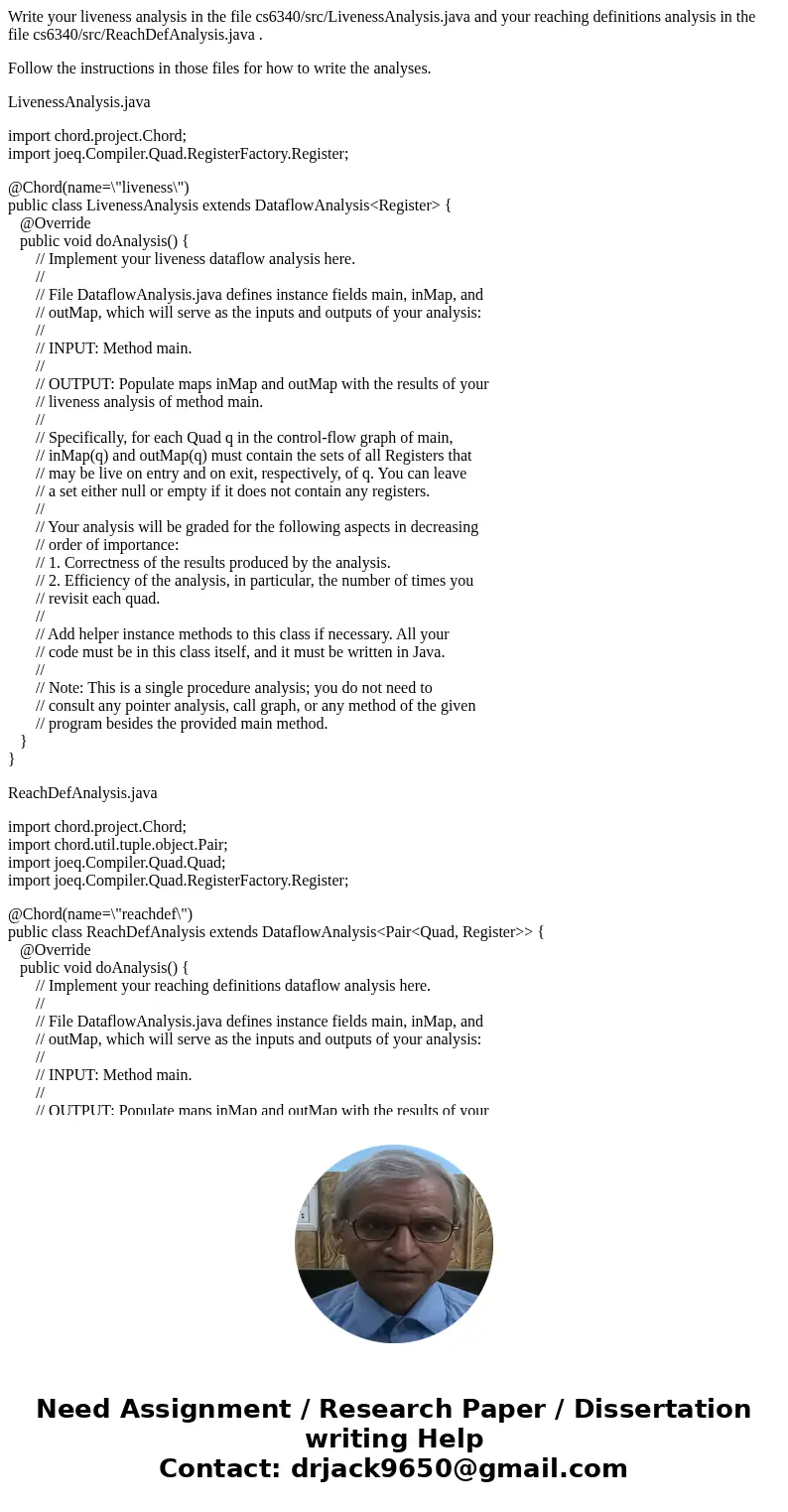
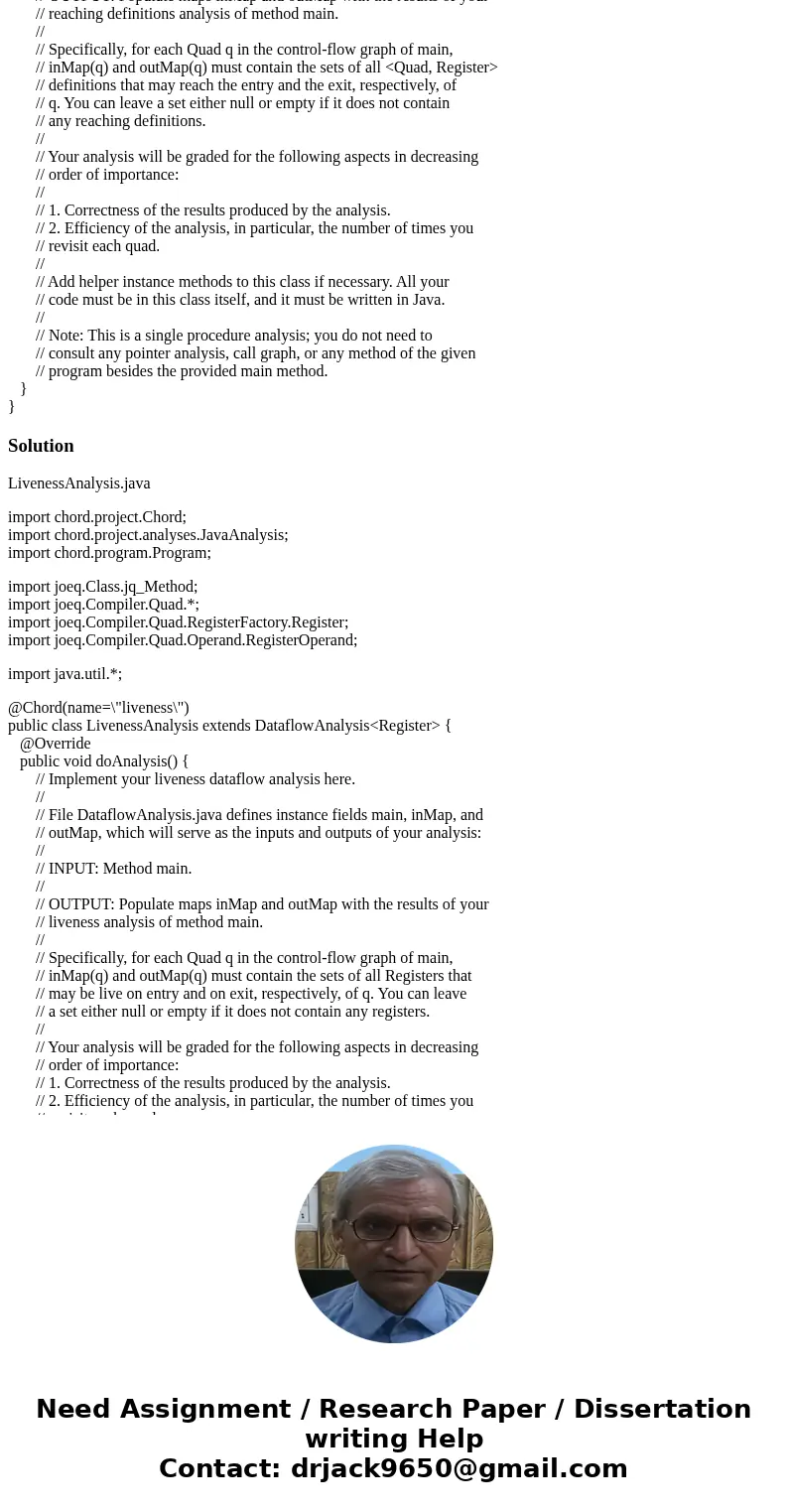
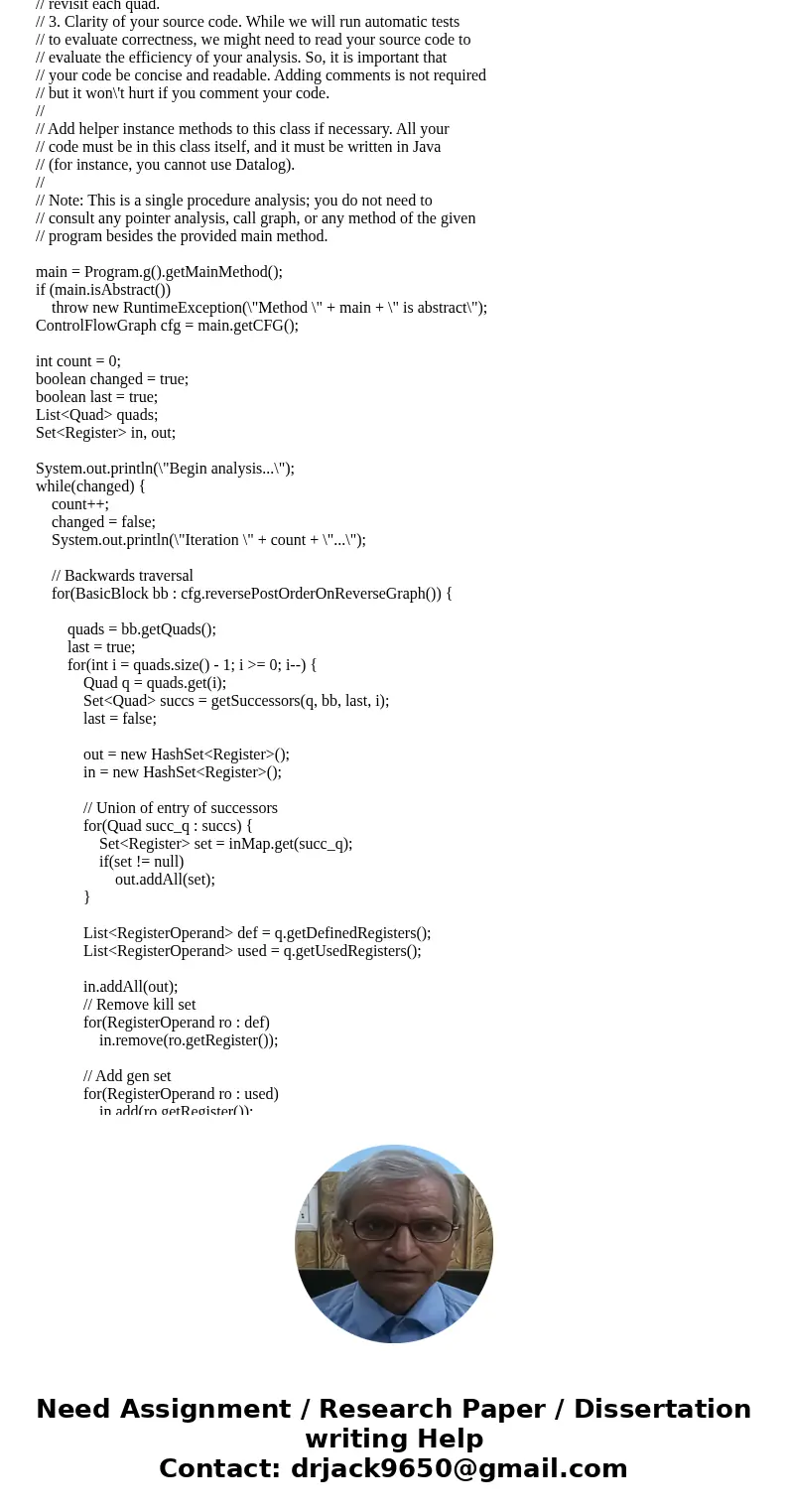
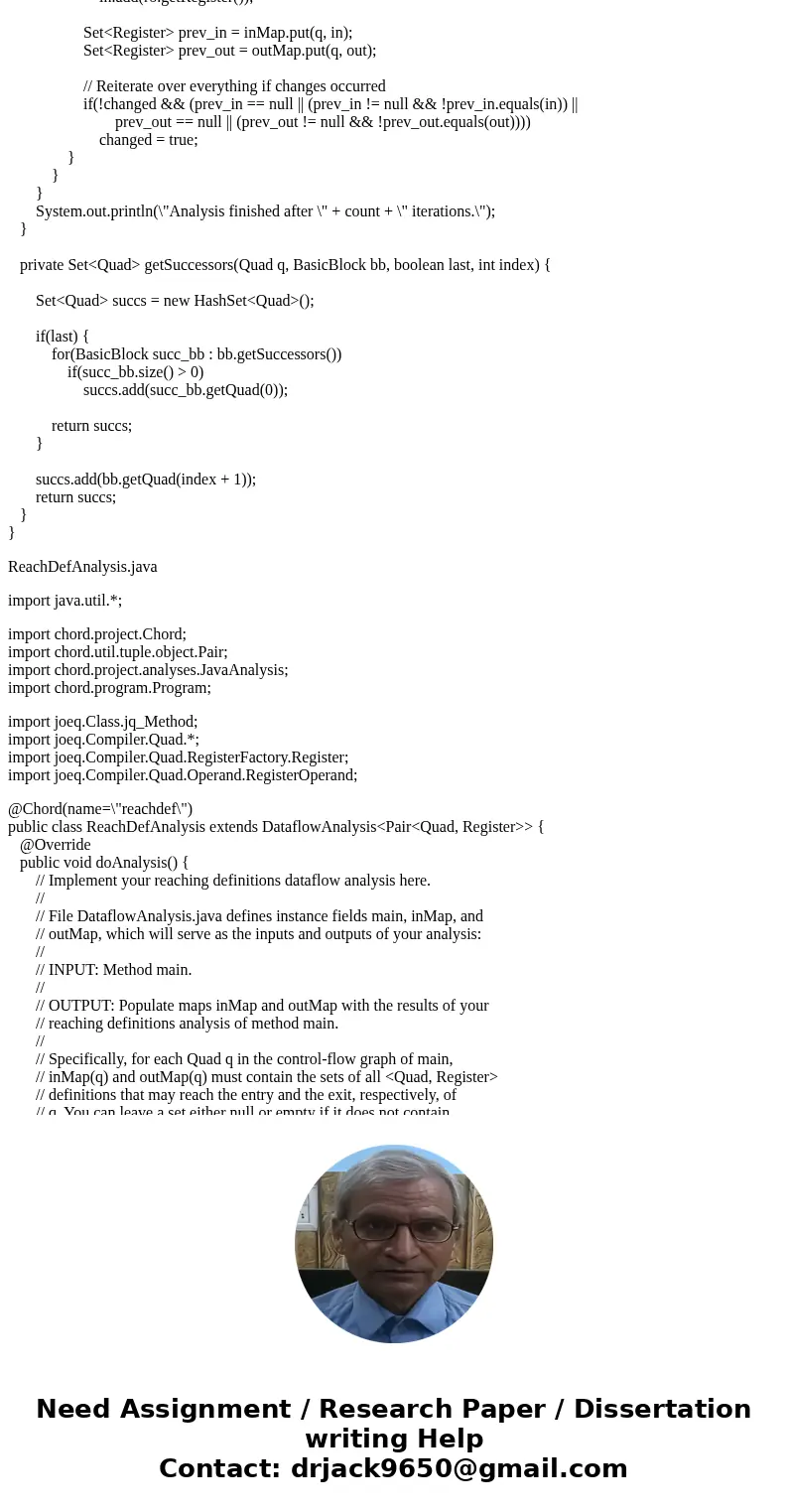
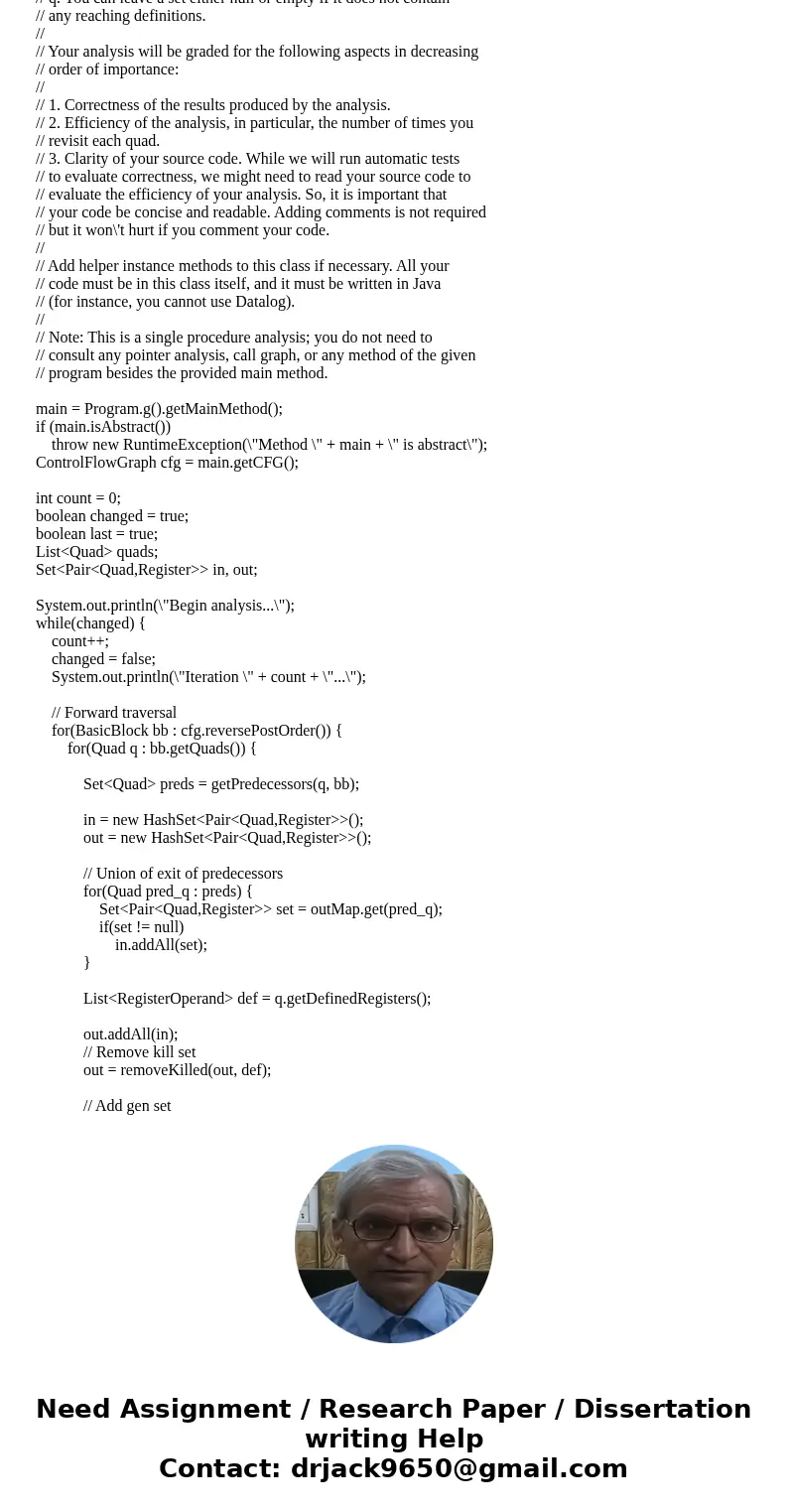
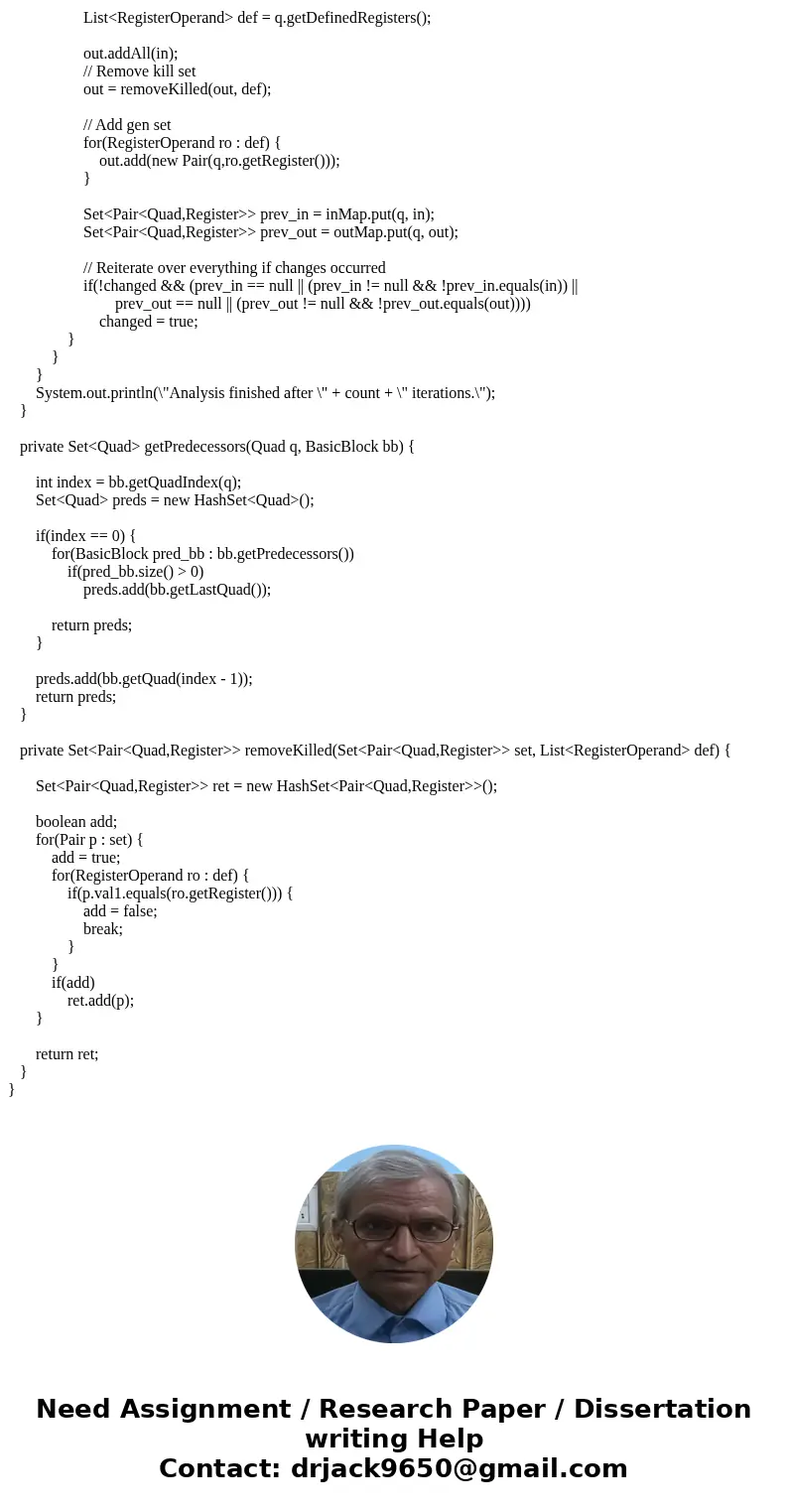
 Homework Sourse
Homework Sourse